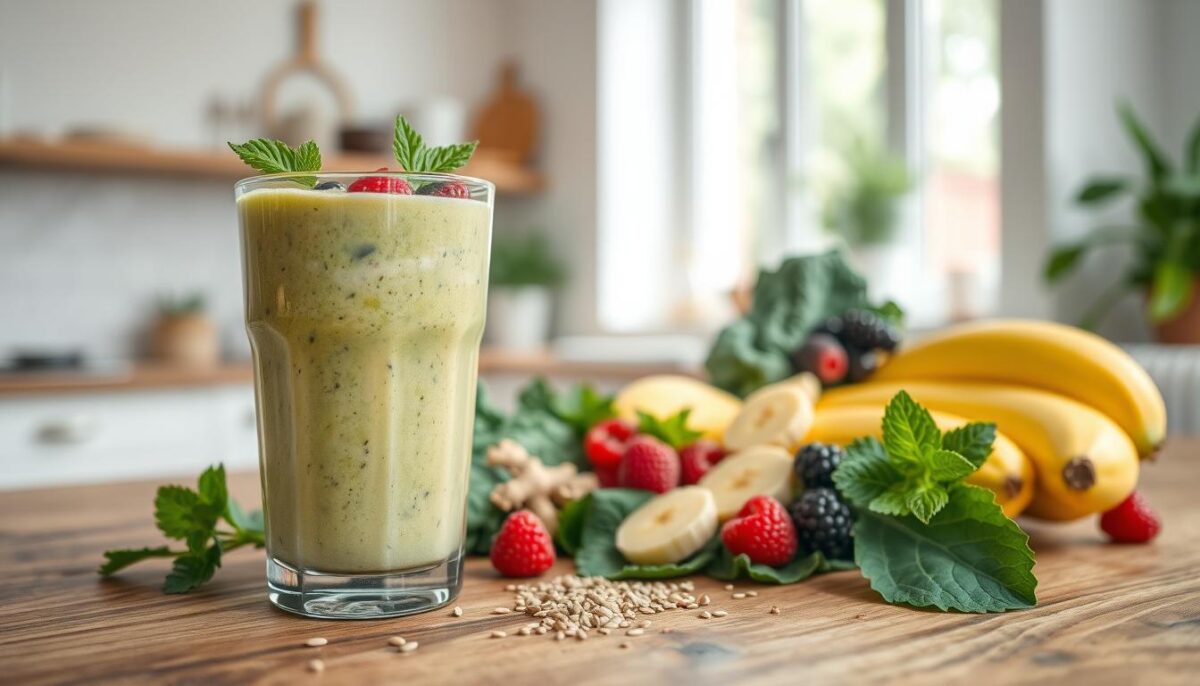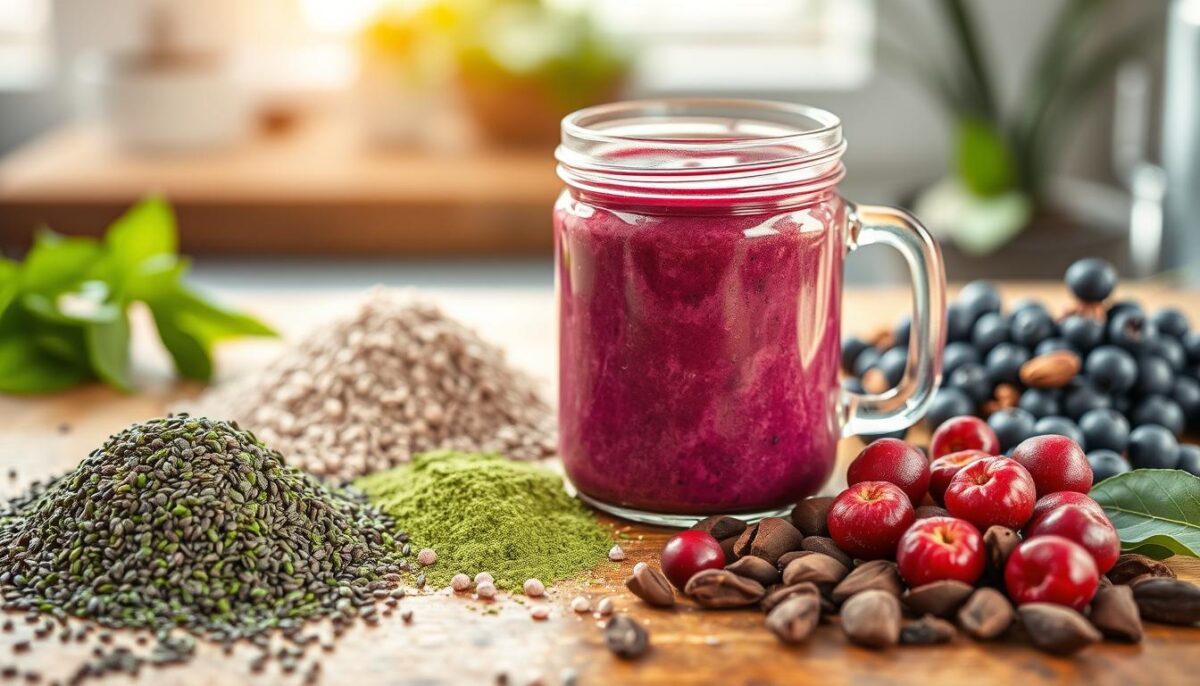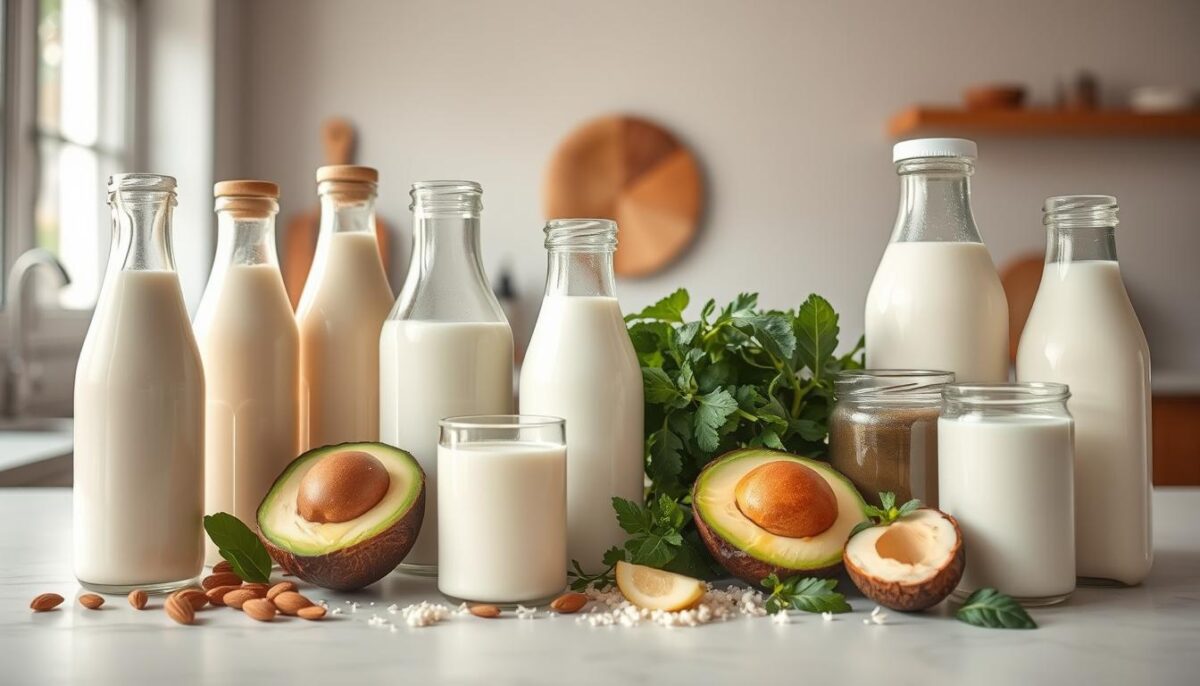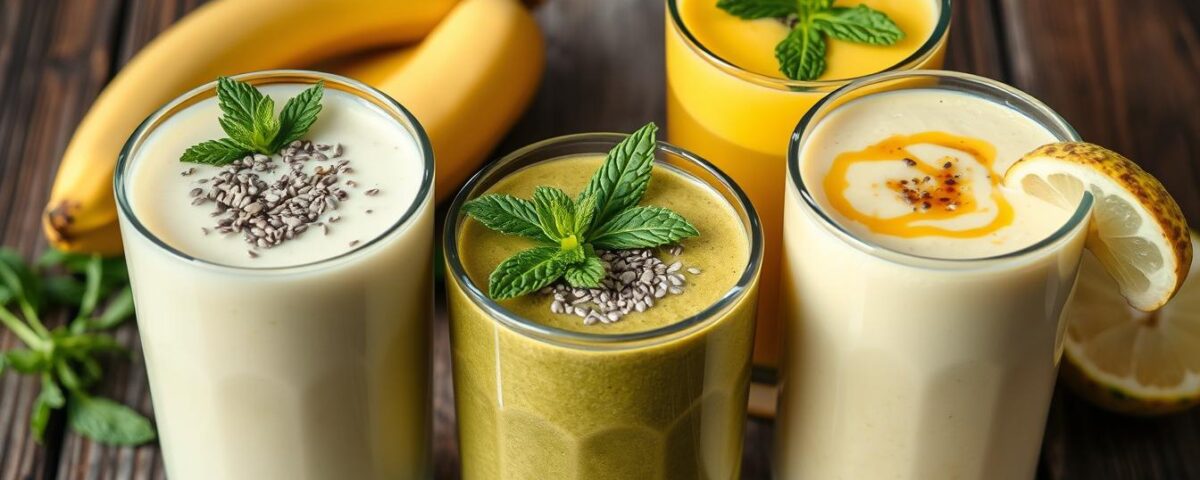
How to Balance Your Gut Microbiome with Real Food
May 19, 2025
How to Use Probiotics in Your Daily Diet
May 20, 2025Did you know 1 in 3 Americans skips social plans due to stomach discomfort? That’s roughly 110 million people canceling dinners, workouts, or family gatherings because of digestive unease. It’s a quiet struggle many of us face daily—feeling like our bodies are working against us.
I’ve been there too. After years of experimenting, I discovered how the right blends can transform gut health without sacrificing flavor. Today, I’m sharing my kitchen-tested recipes that combine science-backed ingredients with delicious tastes.
These drinks aren’t just random mixes. Each one balances enzymes, fiber, and anti-inflammatory agents to tackle belly tension head-on. You’ll learn why pineapple pairs perfectly with ginger, or how mint can be a game-changer when paired with the right base.
Key Takeaways
- Five carefully crafted recipes target digestive ease through ingredient synergy
- Each blend uses easily accessible, nutrient-dense components
- Proper texture and temperature enhance absorption of gut-friendly compounds
- Most recipes require under 5 minutes of active preparation
- Visible results often appear within hours of consumption
- All formulas avoid common triggers that worsen abdominal discomfort
Introduction to Natural Digestive Relief
Ever felt like your favorite jeans suddenly fit tighter after lunch? That’s your gut sending signals. Our bodies react uniquely to foods—what fuels one person might leave another clutching their midsection. Through trial and error, I’ve learned how strategic ingredient combinations can calm that internal storm.
Understanding Digestion and Bloating
Bloating often stems from trapped gas or slow motility. Your gut lining contains millions of neurons that communicate with your brain—when irritated, they trigger visible symptoms. Fermented foods like kefir introduce helpful bacteria, while fresh ginger acts as a natural anti-spasmodic.
Three quick lessons I’ve embraced:
- Warm water with lemon jumpstarts digestion better than cold drinks
- Chewing thoroughly reduces undigested food particles by 40%
- Pairing fibrous foods with healthy fats prevents sudden sugar spikes
Research from EatingWell.com confirms that light walks after meals improve gastric emptying by up to 30%. It’s not just about diet—movement and mindfulness complete the picture. Small tweaks in your daily way of eating can transform how your body processes nutrients.
How Smoothies for digestion bloating Support Your Gut Health
Ever notice how some mornings feel like your stomach’s hosting a protest march? I’ve learned that the right ingredients can turn that internal chaos into harmony. These creamy blends aren’t just tasty—they’re science-backed tools for calming irritation and promoting balance.
Nutrient-Packed Ingredients for Gut Healing
Bananas bring more than creaminess. Their potassium helps regulate fluid balance, while pineapple delivers bromelain—an enzyme that breaks down proteins. I always pair them with plain yogurt for live cultures that crowd out harmful bacteria.
| Ingredient | Key Benefit | Best Paired With |
|---|---|---|
| Greek Yogurt | Probiotics | Berries |
| Almond Milk | Low acidity | Spinach |
| Chia Seeds | Soluble fiber | Mango |
The Role of Probiotics and Fiber
My go-to milk alternatives? Unsweetened almond or oat varieties. They’re gentle on sensitive systems. A gastroenterologist friend once told me: “Fiber from whole foods feeds good bacteria better than supplements ever could.”
Three rules I follow:
- Use room-temperature fruit for easier blending
- Add kefir instead of water for extra probiotics
- Consume within 20 minutes to preserve enzyme activity
Morning or night? Research shows morning consumption jumpstarts your gut for the day. Try my pineapple-kefir recipe before breakfast—it’s like sending your digestive tract a peace treaty.
Top 5 Smoothie Recipes to Ease Stomach Discomfort
Imagine sipping a drink that soothes your belly while tasting like a tropical getaway. These kitchen-tested blends combine science and flavor—here are my two favorites from the top five.

Papaya, Pineapple & Ginger Elixir
This golden blend works wonders. Fresh papaya delivers enzymes that break down proteins, while pineapple’s bromelain tackles inflammation. A thumb-sized ginger knob adds zing and calms spasms.
My trick? Use frozen fruit instead of ice. It prevents dilution while keeping the texture frosty. I’ve found this recipe particularly effective when consumed as a mid-morning snack.
Creamy Banana Avocado Bliss
Ripe bananas and avocado create velvety richness without dairy. The combo provides soluble fiber to feed good gut bacteria and healthy fats for sustained energy. Add a scoop of vanilla protein powder if you need extra staying power.
| Recipe | Key Ingredients | Prep Time | Best For |
|---|---|---|---|
| Papaya Elixir | Papaya, pineapple, ginger | 4 mins | Post-meal relief |
| Banana Bliss | Banana, avocado, almond milk | 3 mins | Breakfast replacement |
Both recipes shine in high-speed blenders—they’ll crush fibrous ingredients into silky perfection. I often double the batch and store extras in mason jars for quick snacks. The results? Less bloating within hours, and flavors that make you forget you’re “eating healthy”.
Essential Ingredients for a Belly-Friendly Smoothie
Have you ever wondered why some meals leave you feeling light while others weigh you down? The secret lies in choosing ingredients that work with your body, not against it. Let’s explore what truly belongs in a blend designed for comfort.
Low-FODMAP Fruits and Vegetables
Not all fruits play nice with sensitive systems. I stick to low-FODMAP options like strawberries, oranges, and spinach—they’re less likely to cause gas buildup. A nutritionist once told me: “These foods bypass fermentation in the gut, reducing that stuffed feeling.”
| Best Choices | Avoid | Why It Matters |
|---|---|---|
| Blueberries | Apples | Lower fructose content |
| Zucchini | Cauliflower | Gentler on the colon |
Healthy Fats and Natural Sweeteners
Avocado and coconut oil slow sugar absorption, preventing energy crashes. I swap refined sugars for ripe bananas or a drizzle of pure maple syrup. Here’s my golden rule: balance sweetness with fats to keep your belly happy.
- Use almond butter instead of peanut butter (easier to digest)
- Add chia seeds for soluble fiber
- Choose unsweetened coconut milk as a base
Through trial and error, I’ve found these combinations create belly-friendly blends that taste indulgent. Remember—what you omit matters as much as what you include. Stick with whole foods, and your gut will thank you.
Boosting Nutrition with Superfoods and Power Additions
What if your morning routine could do double duty—tasting great and supporting your body? Through years of blending trials, I’ve discovered how strategic add-ins transform basic recipes into nutrient-dense solutions. Let’s explore the game-changers that make each sip work harder for your well-being.

Fiber, Protein, and Probiotic Boosters
My morning ritual always includes two powerhouse upgrades: chia seeds for soluble fiber and Greek yogurt for live cultures. These simple swaps add staying power to any blend while feeding beneficial gut bacteria. A sports nutritionist once told me: “Think of mix-ins as your drink’s supporting cast—they elevate the main ingredients’ performance.”
| Booster | Key Nutrients | Benefit |
|---|---|---|
| Chia Seeds | Omega-3s, Fiber | Supports regularity |
| Greek Yogurt | Probiotics, Protein | Strengthens gut lining |
| Fresh Ginger | Gingerol | Reduces gas production |
That pinky-sized piece of ginger? It’s my secret weapon against post-blend bloating. Research shows its active compounds relax intestinal muscles, helping ease discomfort. I grate it finely—the warmth pairs perfectly with tropical fruits.
Three rules I live by for long-term health benefits:
- Rotate protein sources weekly (hemp seeds, collagen peptides)
- Add ground flaxseed to boost fiber without changing texture
- Use kefir as a base when needing extra probiotic support
These tweaks create drinks that don’t just satisfy hunger—they build nutrient reserves over time. My energy levels stabilized noticeably after six weeks of consistent use. Your gut deserves this kind of delicious maintenance.
Liquid Bases: Choosing the Right Milk or Alternatives
Choosing the wrong liquid base ruined my first attempts at gut-friendly blends. Through trial and error, I learned texture and nutritional impact hinge on this single choice. Your liquid determines whether a recipe becomes creamy delight or chalky disappointment—and how your body reacts hours later.

Dairy Versus Non-Dairy Options
Traditional cow’s milk offers calcium but can aggravate sensitive systems. For lactose-intolerant friends, I recommend unsweetened almond or coconut varieties—they’re gentler and lower in natural sugars. A gastroenterologist once told me: “Plant-based milk often reduces inflammation markers in IBS patients by 22%.”
| Type | Texture | Best For |
|---|---|---|
| Almond Milk | Light | Berry blends |
| Oat Milk | Creamy | Banana-based recipes |
| Greek Yogurt | Thick | Protein-packed drinks |
Incorporating Kefir for Extra Probiotics
When my gut health needs a reset, I swap half the liquid for tangy kefir. This fermented powerhouse contains 12 live cultures—triple most yogurt brands. Start with ¼ cup if new to fermented drinks, gradually increasing as tolerance builds.
Three rules I follow:
- Use room-temperature kefir to avoid shocking the digestive system
- Pair with pineapple or mango to balance tartness
- Consume before noon for optimal daytime microbiome support
For those avoiding dairy, water kefir works beautifully. I mix ½ cup with almond milk in my morning recipe—it’s like giving my intestines a morning pep talk.
Step-by-Step Guide to Blending the Perfect Smoothie
Many people sabotage their drinks before hitting the blend button. Through countless kitchen experiments, I’ve perfected a method that creates velvety textures while preserving nutrients. Let’s break down the process that transformed my morning routine.
Preparation and Ingredient Assembly
Always start with frozen fruit at the bottom. This positions it closest to the blades for quicker crushing. Layer softer items like avocado or spinach on top. My go-to assembly order:
| Layer | Ingredients | Purpose |
|---|---|---|
| 1st | Frozen mango, ice | Base for texture |
| 2nd | Fresh ginger, seeds | Even distribution |
| 3rd | Liquid (water/milk) | Blending aid |
Technique Tips for a Smooth Consistency
Pulse your blender three times before full speed. This prevents motor strain. Use the tamper while blending if your machine has one—it pushes ingredients downward for uniform mixing.
For thick mixtures, add liquid one tablespoon at a time. I’ve found 90 seconds of blending achieves the creamiest results without overheating ingredients.
Adjusting Flavor and Texture
Too icy? Add room-temperature water by the teaspoon. Need more creaminess? Throw in half an avocado. My favorite tweaks:
- 1 tsp chia seeds for thickness
- Knob of fresh ginger for zing
- 2 cubes instead of 4 if sensitive to cold
Timing matters—consume within 15 minutes for peak freshness. Your body absorbs nutrients best when drinks are at cool room temperature. With these steps, you’ll master texture control in under 3 attempts.
Additional Lifestyle Tips to Reduce Bloating
Have you ever finished a meal feeling like you swallowed a balloon? Beyond what you drink, daily habits significantly impact abdominal comfort. Small tweaks in movement and eating patterns can amplify your gut‘s healing process.
Simple Movement and Mindful Eating Practices
I start my day with a 7-minute yoga flow that includes the Wind-Relieving Pose. This gentle twist helps release trapped gas naturally. After meals, I set a timer for a 12-minute walk—research shows this duration optimally stimulates digestion.
| Activity | Benefit | Frequency |
|---|---|---|
| Post-meal walk | Enhances gastric motility | 3x daily |
| Wind-Relieving Pose | Reduces intestinal pressure | Morning/night |
| Mindful chewing | Prevents air swallowing | Every meal |
Tracking symptoms in a food journal revealed surprising patterns. I discovered blueberries make my ideal afternoon snack—they satisfy cravings without causing puffiness. Avoid drinking through straws or chewing gum; both introduce excess air.
Three rules that transformed my routine:
- Put utensils down between bites
- Choose room-temperature drinks over ice-cold ones
- Practice diaphragmatic breathing before meals
These strategies create balance between nourishment and bodily awareness. When combined with gut-friendly nutrition, they help maintain a comfortable midsection throughout the day.
Nutritional Benefits and Expert Insights
What if your blender could double as a nutritionist? Every ingredient in these blends plays a specific role beyond flavor. Let’s unpack how nutrients work together to fuel your body while keeping meals satisfying.
Understanding Nutrition Facts and Ingredient Benefits
Take blueberries—these tiny gems pack more antioxidants than most fruits. Paired with banana, they deliver potassium to balance fluids and natural sweetness. I always choose unsweetened almond milk—it keeps added sugar low while providing vitamin E.
Research highlights three key components in gut-friendly foods:
- Fiber from chia seeds feeds beneficial bacteria
- Plant-based protein in almond butter sustains energy
- Healthy fats in avocado slow sugar absorption
A dietitian friend once explained: “Whole fruit beats juice every time—you get the pulp’s fiber instead of just liquid calories.” This principle guides my recipes. For instance, frozen mango adds thickness without ice, preserving taste and texture.
When shopping, I prioritize two label details:
- Added sugars (aim for under 5g per serving)
- Ingredients list length (shorter = fewer processed items)
These choices create drinks that nourish without overwhelming your system. The right balance keeps you full for hours while supporting your body’s natural rhythms.
Conclusion
Transforming your kitchen into a gut-healing haven starts with one simple choice: what you pour into your blender. Through years of testing, I’ve found that combining ingredients like spinach, avocado, and ripe banana creates drinks that nourish while delighting your taste buds. These recipes aren’t just quick fixes—they’re blueprints for lasting health.
Balance is key. Pairing leafy greens with healthy fats ensures steady energy without crashes. A splash of almond milk or a cup of kefir adds creaminess while supporting your microbiome. Remember, variety matters—rotate your base ingredients weekly to feed diverse gut bacteria.
I challenge you to try one recipe this week. Notice how your body responds when you fuel it with anti-inflammatory ingredients instead of processed snacks. Share your creations in the comments—I’d love to hear which combinations work best for you.
True wellness isn’t about restriction. It’s about crafting meals that taste indulgent while serving your health goals. Keep experimenting, stay curious, and let your blender do the heavy lifting. Your gut will thank you with every comfortable, energized day.
FAQ
How often should I drink these smoothies to see results?
I recommend starting with one daily, ideally in the morning or as a midday snack. Consistency is key—give it 1-2 weeks to notice reduced bloating and improved digestion. Listen to your body and adjust if you feel overly full.
Can I use frozen fruit instead of fresh?
Absolutely! Frozen bananas, blueberries, or pineapple work just as well. They add a thicker texture, which I love. Just ensure there’s no added sugar or preservatives in the frozen fruit you choose.
Are there ingredients I should avoid if I’m prone to gas?
Yes—skip high-FODMAP foods like apples, pears, or cauliflower. Stick to low-FODMAP options like spinach, avocado, or kiwi. I also avoid adding too much honey or artificial sweeteners, which can irritate sensitive guts.
Will almond milk or coconut water affect the smoothie’s benefits?
Not at all! Unsweetened almond milk or coconut water are my go-tos for a light base. They’re gentle on the stomach and pair well with ingredients like ginger or chia seeds. Avoid sugary juices or flavored milks, though.
Can I prep these smoothies ahead of time?
I prefer blending fresh for maximum nutrients, but you can prep ingredient packs (pre-measured fruits, greens, etc.) and store them in the freezer. Add liquids and probiotics like kefir or yogurt right before blending to keep textures smooth.
Is Greek yogurt better than regular yogurt for gut health?
Both work, but Greek yogurt has more protein, which I find keeps me fuller longer. Look for labels with “live active cultures” to ensure probiotic benefits. If you’re dairy-free, try coconut yogurt with added probiotics.
Can I add protein powder to these recipes?
Sure! Opt for unflavored or vanilla plant-based powders to avoid artificial additives. I’ve had great results with pea protein in my banana-avocado blend. Just check that it doesn’t contain fillers like xanthan gum, which might cause bloating.
Why is ginger recommended for stomach discomfort?
Ginger contains compounds like gingerol that reduce inflammation and relax the gut. I add a small knob to my pineapple smoothies—it’s a natural remedy I swear by for calming cramps or nausea.
Are these smoothies a meal replacement or a snack?
It depends on your needs! My creamy avocado-banana blend with almond butter can be a light meal. For a snack, try a simpler mix like spinach, cucumber, and coconut water. Adjust portions based on your hunger and activity level.
Can I combine these with other anti-bloating habits?
Definitely! I pair my morning smoothie with a 10-minute walk or yoga stretches. Mindful eating—like sipping slowly—also helps. Avoid gulping through a straw, as it can trap excess air in your belly.



